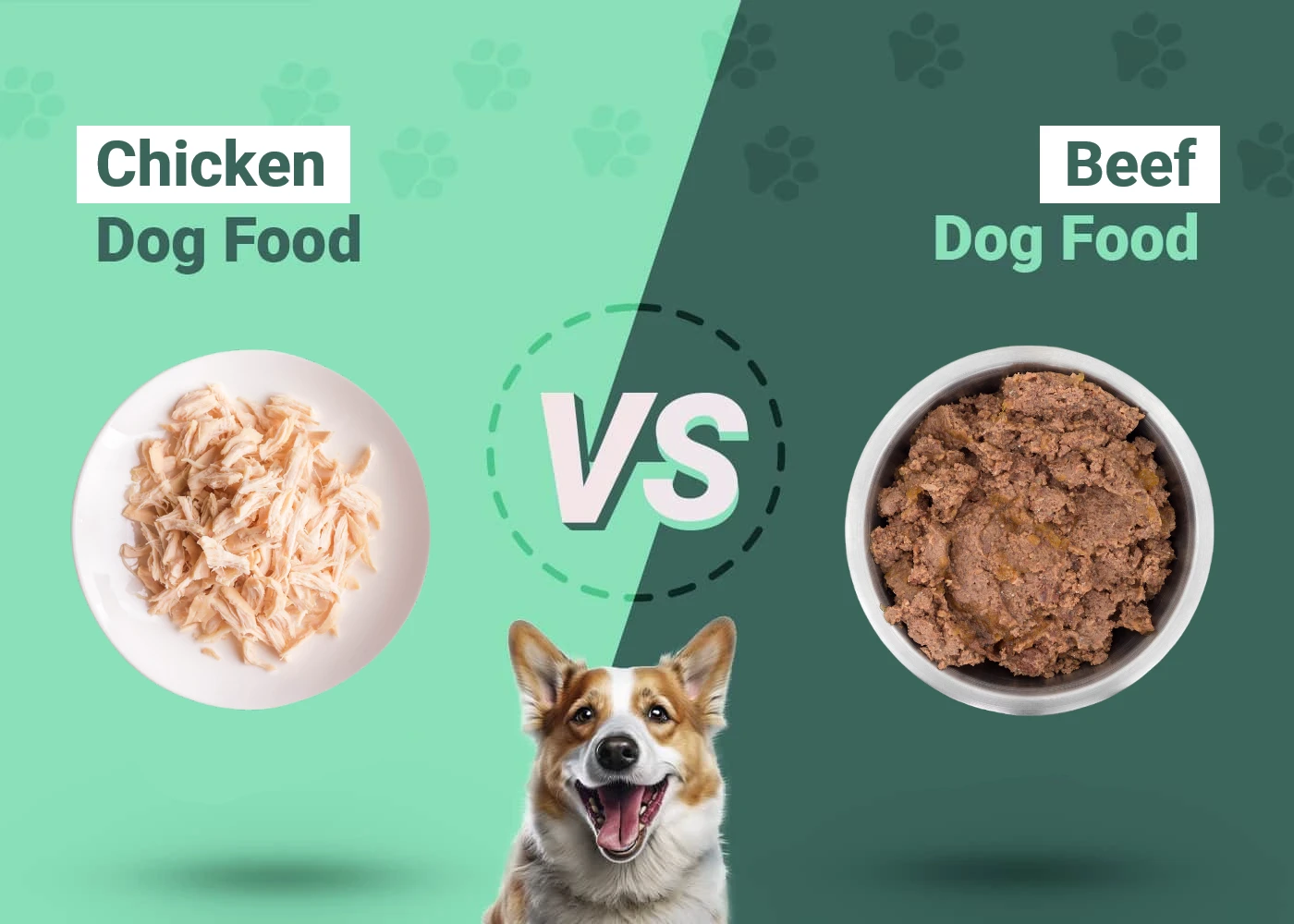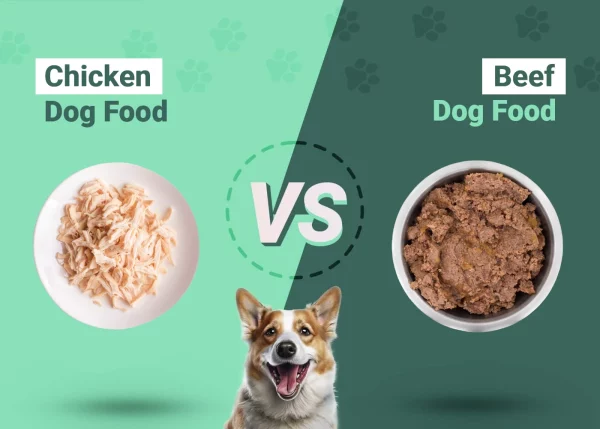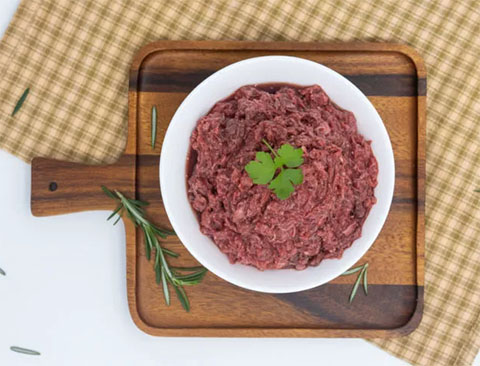Dog food comes in a variety of options for proteins and formulas. From classics like chicken and turkey to novel proteins like duck, wild-caught fish, and rabbit, you have no shortage of choices for what to feed your dog to keep things interesting.
Of course, all this variety can be dizzying for pet owners. Chicken and beef are two widely available proteins that most dogs love, but each offers different nutritional content and benefits. Both can be triggers for dog food allergies as well.
At a glance, chicken has the benefits of being high in protein and low in fat with among the best digestibility of all meats. Beef is also protein-rich and packed with nutrients, but it’s higher in fat than chicken.
At a Glance
Let’s look at the key points of each product.
- High in protein
- Low in fat
- High bioavailability (digestibility)
- Relatively inexpensive
- Rich source of omega fatty acids
- Natural source of glucosamine
- Protein-rich
- Excellent source of zinc, iron, and selenium
- Rich in vitamins
- High in fat/calories for energy needs
- Less common food allergen
Overview of Chicken
Chicken is a commonly used protein in dog food, either as whole deboned chicken, chicken meal, chicken by-products, chicken organ meat, or chicken fat and broth. With its high bioavailability, it’s an easily digestible meat to ensure your dog gets the nutrition it needs. It’s relatively inexpensive, especially compared to other meats, even with organic or free-range options, and offers an abundance of lean protein. Low in fat, chicken ensures that dogs get the protein they need without added calories from fat.
Along with protein, chicken is a rich source of omega-6 fatty acids and glucosamine for skin, coat, and joint health. For dogs with sensitive stomachs, chicken is bland enough to minimize gastrointestinal upset. Unfortunately, chicken is also one of the most common food allergies in dogs. It’s also a bit boring as a daily diet for dogs, though different recipes can help.
- High in protein
- Low in fat
- Nutrient-dense
- Bland
- Inexpensive
- Common food allergen
- Boring
Overview of Beef
Beef is widely available in dog food recipes. It may be included as whole meat, beef organs, beef fat, beef broth, or beef meal and by-products. No matter the cut, beef is a protein-rich meat that offers a full range of essential amino acids and nutrients like iron, selenium, and zinc. For dogs with high energy and trouble maintaining weight, beef has a high fat content. Though dogs may be allergic to it, food allergies are less common in beef than in chicken.
Though not as bland as chicken, beef can also be used for transitioning diets and preventing digestive upset in sensitive dogs. Depending on the quality and cut, beef is more expensive than chicken. The high fat content is good for dogs with high energy, but it can lead to weight gain. Also, dogs that are prone to digestive upset from high fat foods may have issues with high-fat beef recipes.
- Protein-rich
- Essential amino acids and nutrients
- Rich source of heme iron
- High fat for energy needs
- Less common for food allergies
- More expensive than chicken
- High in fat and calories
What Are the Differences Between Them?
Protein
Edge: Tie
Both chicken and beef are excellent sources of protein for dogs and offer all essential amino acids. The difference lies in the fat content. Chicken is a lean protein source with a low fat content, which is ideal for dogs on a weight management diet or dogs that have sensitive stomachs. Beef is higher in fat to support energetic dogs that require more calories, but the high fat content can lead to obesity or digestive upset in some dogs.
Price
Edge: Chicken
For quality meat sources, chicken has the edge over beef in price. It’s cheaper than most cuts of beef, which is part of why it’s so often used in dog food recipes. Beef’s cost depends on the cuts used and the quality of the livestock, but overall, it’s more expensive pound for pound than chicken. That high cost doesn’t necessarily translate to better nutritional value, either.
Allergens
Edge: Beef
Both beef and chicken can contribute to food allergies in dogs. Chicken is far more common as an allergen, however. That said, dogs can develop an allergy to a variety of ingredients, so beef can easily become an issue as well. In this case, rotational diets or novel proteins may be superior to either chicken or beef.
Digestion
Edge: Chicken
Chicken has high bioavailability, meaning it’s highly digestible. It’s also bland from the low fat content, so it’s good for dogs with sensitive stomachs. Beef is also digestible and can be good for dogs prone to digestive upset, but the fat should be removed first. For some dogs, high fat content can contribute to gastrointestinal distress.
What the Users Say
With the results so close, we researched what dog owners had to say about chicken vs. beef in dog food recipes in reviews and forum discussions.
Overall, the community is divided between chicken and beef. Some dogs do better on chicken-based diets, especially if they’re small or struggle with weight loss or maintenance. Chicken offers lean protein that won’t pack on the pounds. But dog owners who choose beef recipes generally see good results for their dogs, especially with higher-quality beef recipes. Beef is also the preferred choice for dogs with known food allergies. Some owners struggle with the high cost of beef, however.
Ultimately, the choice depends on your dog and its specific nutritional needs, your budget, and the food formula you choose. If you want the best of both worlds, a rotational diet that includes both chicken and beef gives you the benefits of lean protein, glucosamine, and omega fatty acids with the rich heme iron and protein of beef.
Rotational diets have other benefits as well, including alleviating food allergies. An allergy can develop if your dog is eating the same food day in and day out, and rotating proteins is thought to lower the risk of them having an allergy to a particular protein or ingredient. It also helps with balancing the high cost of beef and the lower cost of chicken.
We like variety in our meals. In fact, food boredom is one of the reasons that many people struggle with strict diets. Our dogs don’t have much choice in the matter, but we can give them some variety in their menus to keep things enticing and offer a wider range of nutrient sources and benefits.
Summary
Both chicken and beef offer rich protein and a variety of essential vitamins and minerals for dogs. While chicken is leaner than beef and ideal for a low-calorie or weight maintenance diet, beef is rich in iron and offers animal fat for high-energy dogs. Beef is more expensive, however, and chicken is more likely to trigger allergies in dogs, so it’s up to you to weigh the pros and cons for your dog’s needs and your budget.
Featured Image Credit: Left – jiaming xie, Shutterstock | Right – BW Folsom, Shutterstock

















